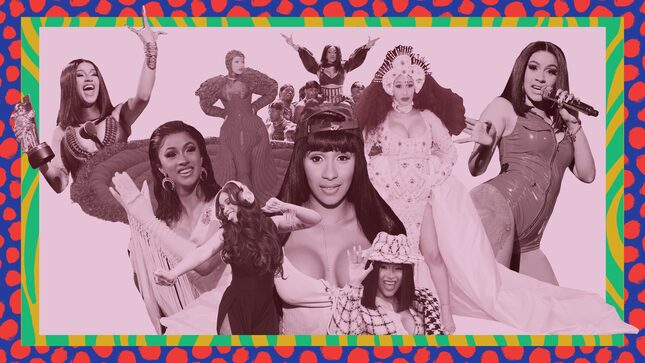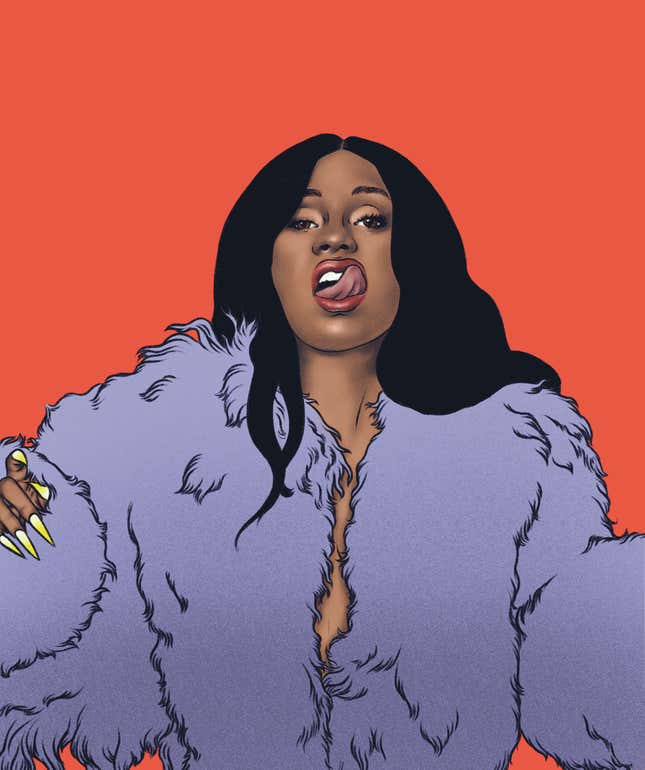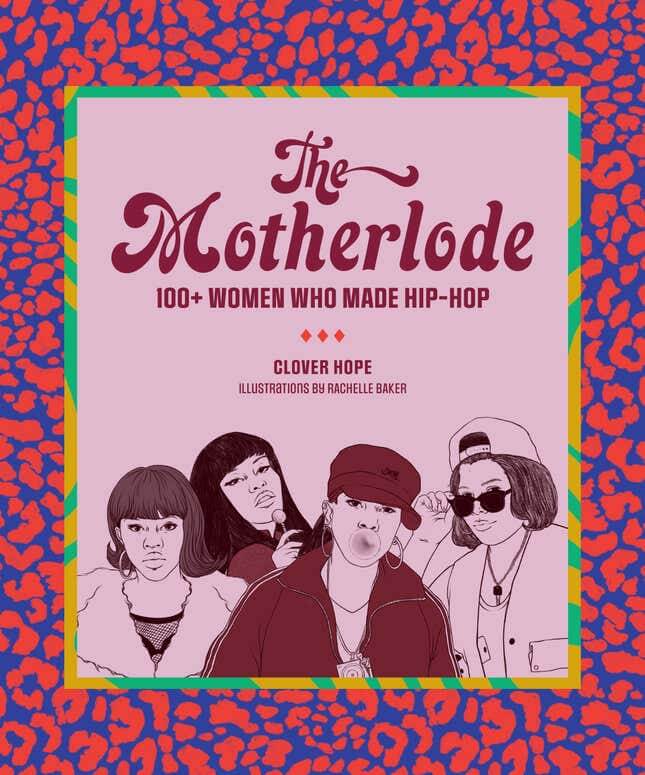
Graphic: Elena Scotti (Photos: Getty Images)
Instagram launched a simple yet radical feature in June 2013: the ability to upload videos in addition to photos. Finally, users could bombard their followers with fifteen-second snippets of their lives, which was a bad omen for Vine, the six-second video app made popular by teens. (Vine died three years later.) But it was life-changing for people like Cardi B.
Back then, Cardi was a little-known stripper from the Bronx who quickly became famous through Instagram. Her videos, shot in the style of ad hoc tutorials, featured practical advice—about men, love, and money—based on her own life experiences. “That ain’t no way to live, hatin’ on hoes,” she would say (more likely, scream) into a front-facing camera. “When ya man don’t call you . . . you call his side bitch, like deep-deep-deep, hello?!” And so on.
She was open about everything: her daily moods, sexuality, financial ambitions, butt and breast augmentations. People loved her honesty, plus her comedy lent itself to the speed and flash of social media (her videos spread to places like Tumblr, Twitter, and Vine), which she understood as a space for persona-building.
Cardi’s personality became a bright spot amid all the artifice, and her following grew into the millions, then in 2015, internet fame got her cast on the VH1 reality show Love & Hip Hop. Her appeal was instant and infectious. “Hey, Amurrica, what’s poppin’? My name is Cardi B,” she said in her TV debut. “You might know me as that annoying dancer on social media that be talkin’ hella shit, with the long nails and the big ol’ titties.”
The gap between Love & Hip-Hop and Cardi’s becoming the wittiest rapper alive was astonishingly brief. The speed and intensity of her run was impressive and meticulously documented. Cardi went from releasing okay music to good music. In 2017, she dropped two mixtapes: Gangsta Bitch Music Vol. 1 and Gangsta Bitch Music Vol. 2. The latter featured a skit titled “Leave That Bitch Alone,” where she checks her man for “taking bitches to Outback,” when he knows it’s her favorite restaurant. (This was after she essentially turned Instagram commentary into a rap song with 2015’s “Cheap Ass Weave.”) These earlier mixtapes showed a rapper with room for growth. Step by step, people witnessed Cardi transform from internet icon to reality-TV personality to superstar in real time. Partnering with rapper Pardison Fontaine—who she met at the strip club Sue’s Rendezvous when both were green—helped her get sharp. Fontaine said to GQ, “I knew she was a personality on Instagram and that people already liked her. I knew there had to be something there.”

Traditionally, most rappers get exiled for openly using ghostwriters or other songwriters. Cardi admitted she needed help. Fontaine coached her through rapping and co-wrote her lyrics. “Yeah, I co-wrote, bitch,” she said onstage at a show once. “I don’t give a fuck. All these rappers out here got writers. Even the ones that say they don’t. They lying, bitch. They do. I don’t give a fuck . . . I’m still gonna get paid, hoe.” And so she did.
By the following summer, she had a surprise hit: “Bodak Yellow.” The song’s harsh, metallic beat was distinctly New York and aesthetically Cardi—charming yet threatening—and the lyrics were thoroughly quotable.
You could neither fuck with nor avoid Cardi B at that point. “Bodak Yellow” made her only the second female rapper to have a No. 1 song on the Billboard Hot 100 chart without a featured guest, after Lauryn Hill in 1998. She rapped on G-Eazy’s “No Limit,” on Migos’ “MotorSport,” on Bruno Mars’s “Finesse (Remix).” Then her debut album, Invasion of Privacy, released in April 2018, went to No. 1. And her Latin-trap single, “I Like It,” later topped the Hot 100, making Cardi the first and only female rapper to have two No. 1 records on the chart.
Cardi found herself in rare company again, becoming just the third female rapper to score a Grammy nomination for Album of the Year, next to Lauryn Hill and Missy Elliott. While Nicki Minaj managed to walk that fine line between street and corporate rap, Cardi was the embodiment of authenticity.
“You got Cardi, she’s a stripper, and she’s, like, ‘What? I don’t have the best grammar, and I’m not trying to be anybody’s role model, by the way. All I really need is money,’ ” says Karen Good Marable. “She’s not part of a straight-up boy clique. She’s just kind of self-actualizing, but she comes out of strip clubs, which is a male-dominated environment.” As a former stripper, Cardi understood the nature of control, which probably helped her navigate a music business where control has to often be earned. “I think Kim took those lumps so that these women can be a little bit more in the driver’s seat. They’re not putting themselves in a box, and they’re not letting other people do it,” says Good Marable.
Historically, there’ve been limited ways for female rappers to climb up the chain. More often, opportunity knocked through gatekeeping men, both in front of and behind the scenes. History implies that women in rap need a man backing them to rise to the level of a superstar. But the odds were in Cardi’s favor by the time she blew up. There were many more entry points into fame (reality TV, social media) and a lot more measures of popularity, compared to what the women before her had. There was also a shift from radio, to mixtapes, to internet and streaming, which changed the narrative of stardom.
Whereas the street mixtape economy boosted Nicki Minaj’s career early on, the streaming explosion, paired with the reach of social media, gave a generation of internet rappers an advantage; for example, Soulja Boy becoming famous via YouTube, and Belcalis becoming Cardi B through Instagram. The New Yorker’s Briana Younger wrote in 2018, “Thanks to platforms such as YouTube, Twitter, SoundCloud, and Instagram, along with the pseudo-democracy of streaming services, women can tap into their audiences directly and find measurable success.”
Cardi was part of a big trend: Instagram and Twitter as brand extensions for average citizens and brilliant animals, not just celebrities. She refined her image on social media, but she was always a star. In 2015, when she went from stripping to making money through hosting and paid appearances, opportunities afforded to her because of her local celebrity and cult status on the internet, she quit the strip-club gigs altogether. And if there was anywhere she could go, it was toward rap.
“For someone like Cardi, what were her options to amplify her larger than lifeness?” says former Vibe editor Elizabeth Méndez Berry. “She’s like, what format can I compress myself into that maximizes my personality? She does that with her Instagram posts and in her songs. Hip-hop gives you that density of language, that vividness that is perfect for her because nobody else talks like her. When you hear it, you feel like, Oh my God this woman is able to bring us into her life with a proximity and detail and comedy. She’s literally built for this.”
Cardi was honest about her motives with rap—and that her goal was to make hits that could make her money. “I’m a hoe. I’m a stripper hoe. I’m about this shmoney,” she said in an early Instagram video. She said to FADER, “At the end of the day, you need to be with what sells . . . I have a passion for music, I love music. But I also have a passion for money and paying my bills.”
Aspiring rappers on Love & Hip Hop try to use the show as a fast-track career boost, a place to promote their bad music, to invent caricatures and story lines for marginal amounts of fame. But most of them fail. Cardi B is the franchise’s biggest success story—a social media personality who became more famous on TV and then again through the medium of rap. On camera, she played to the drama, getting caught up in a love triangle, and constantly name-dropped her then-boyfriend, who was in prison.
Cardi could’ve run into the same reality-TV fate as her castmates. But she was not like the others. After two seasons, she made her smartest move yet and quit the show to pursue a real-world career— the “and Hip-Hop” part—instead of just talking about it on television. She quickly went from invading everyone’s living rooms to becoming a rap star. She didn’t have years of tutelage with a male rapper or super producer—she barely knew how to rap at first. And she didn’t come from the underground or debut with a popular crew. Instead, she offered a new bootstrap model for success created in her own image, ingeniously through social media.
The trifecta of Nicki, Azealia, and Cardi begat a new generation of women who would find success by building their own appealing personas and forcing heads to turn in their direction. “Labels were signing female rappers and putting them in a shelf and not focusing on them,” Cardi tweeted in 2019. “Bitches been rapping, bitches been have talent, but the music industry wasn’t believing.”
Social media is often about synthesizing thoughts and moments into bursts of comedy. Vine was all about making people laugh, and Cardi had comedic delivery and timing and knew how to sell charm. Her Instagram videos featured countless messages of erotic advice, and her Twitter account was a constant source of truth. Sample: “Type of sex that when we finish I got one eyelash missing . . . that’s what I want right now.” When she got a new set of veneer teeth and went on an interview to show them off, she joked, “I even smile when I’m mad [now].” On her debut album, Invasion of Privacy, she threatens to “make a bowl of cereal with a teaspoon of bleach” as revenge against a cheater on one song, “Thru Your Phone.”
When stamping a debut album as a classic, rap fans tend to rely on metrics of perfection. The length of the album is considered. No skips. Great production. Nas’s Illmatic, Jay-Z’s Reasonable Doubt, and Lauryn Hill’s The Miseducation of Lauryn Hill all make the cut, but few albums by female rappers get on people’s lists. Invasion of Privacy was the best rap debut in years and belongs in the canon along with Lil’ Kim’s Hard Core and Miseducation. It isn’t as perfect as other classic debuts, but it is highly listenable; it represents a seismic moment in rap and the fully actualized version of Cardi B.

Invasion of Privacy jump-started a new era for women rappers in which success felt much more tangible. When Cardi collaborated with a then-blossoming star, Megan Thee Stallion, on “WAP”—a perfectly crafted duet about the slipperiness of their vaginas—it was a symbol of dominance. The music video, released in the middle of the pandemic of 2020, showed the two of them prancing through bright hallways in tandem and doing full splits with bare, oiled derrières. Not only were two women in peak position in rap syncing their skills effortlessly and tension-free, but also symbolically, this was the culmination of decades of work from their predecessors who set the stage for raunchy rap by black women to be shamelessly lauded. Like Salt-N-Pepa, like Lil’ Kim, like Trina, like Foxy Brown, both Cardi and Megan were the centers of a provocative universe, but instead of men laying the dominos, it was about women making music for women’s enjoyment, reclaiming the object gaze and the vision of sexuality that men had monopolized.
After years of debates about the lack of female rappers, Nicki Minaj updated the blueprint for success and Cardi multiplied the wealth of talent and resurrected the idea that numerous women who controlled their own stories could dominate rap at once. Never again would there only be one.
The Motherlode, by Clover Hope; Illustrations by Rachelle Baker © Abrams Image, 2021